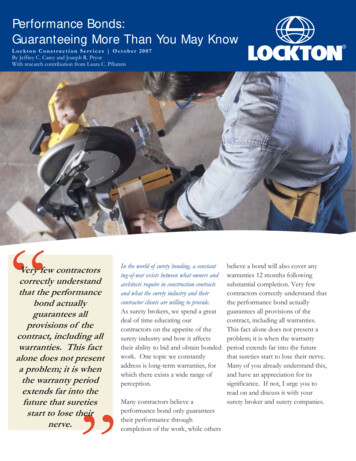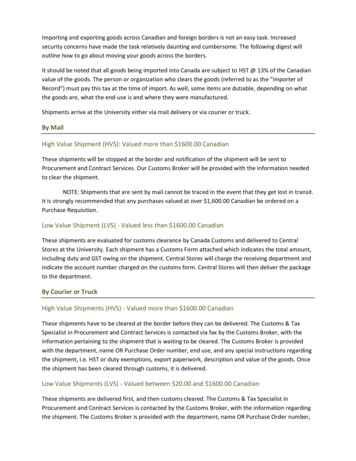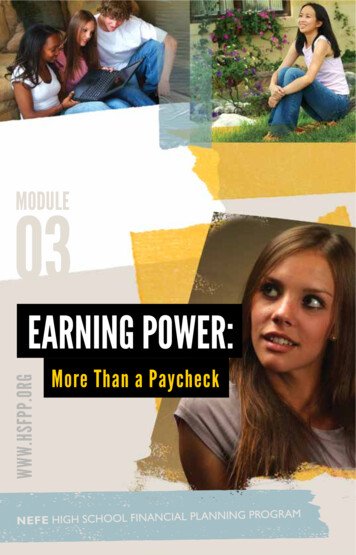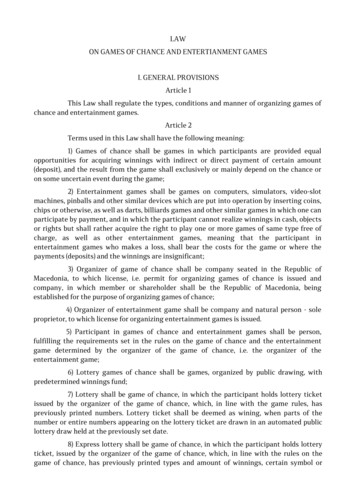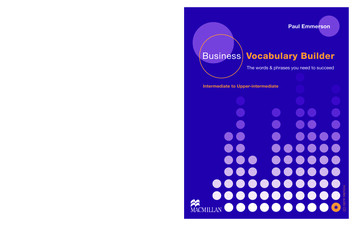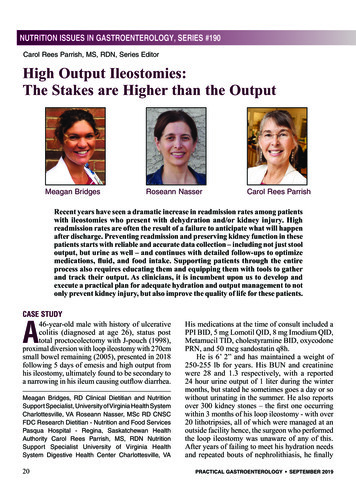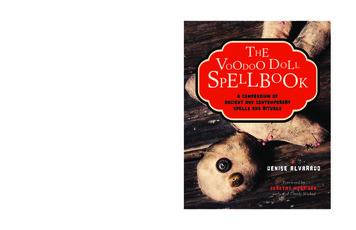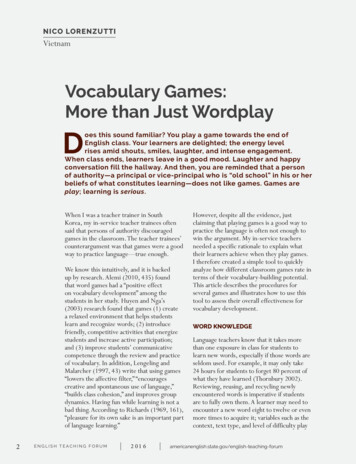
Transcription
NICO LORENZUTTIVietnamVocabulary Games:More than Just WordplayDoes this sound familiar? You play a game towards the end ofEnglish class. Your learners are delighted; the energy levelrises amid shouts, smiles, laughter, and intense engagement.When class ends, learners leave in a good mood. Laughter and happyconversation fill the hallway. And then, you are reminded that a personof authority—a principal or vice-principal who is “old school” in his or herbeliefs of what constitutes learning—does not like games. Games areplay; learning is serious.When I was a teacher trainer in SouthKorea, my in-service teacher trainees oftensaid that persons of authority discouragedgames in the classroom. The teacher trainees’counterargument was that games were a goodway to practice language—true enough.We know this intuitively, and it is backedup by research. Alemi (2010, 435) foundthat word games had a “positive effecton vocabulary development” among thestudents in her study. Huyen and Nga’s(2003) research found that games (1) createa relaxed environment that helps studentslearn and recognize words; (2) introducefriendly, competitive activities that energizestudents and increase active participation;and (3) improve students’ communicativecompetence through the review and practiceof vocabulary. In addition, Lengeling andMalarcher (1997, 43) write that using games“lowers the affective filter,” “encouragescreative and spontaneous use of language,”“builds class cohesion,” and improves groupdynamics. Having fun while learning is not abad thing. According to Richards (1969, 161),“pleasure for its own sake is an important partof language learning.”2ENGLISH TEACHING FORUM2 01 6However, despite all the evidence, justclaiming that playing games is a good way topractice the language is often not enough towin the argument. My in-service teachersneeded a specific rationale to explain whattheir learners achieve when they play games.I therefore created a simple tool to quicklyanalyze how different classroom games rate interms of their vocabulary-building potential.This article describes the procedures forseveral games and illustrates how to use thistool to assess their overall effectiveness forvocabulary development.WORD KNOWLEDGELanguage teachers know that it takes morethan one exposure in class for students tolearn new words, especially if those words areseldom used. For example, it may only take24 hours for students to forget 80 percent ofwhat they have learned (Thornbury 2002).Reviewing, reusing, and recycling newlyencountered words is imperative if studentsare to fully own them. A learner may need toencounter a new word eight to twelve or evenmore times to acquire it; variables such as thecontext, text type, and level of difficulty um
an important role in vocabulary acquisition(Nation 2014; Webb 2007). To maximizevocabulary development, teachers shouldintentionally repeat the exposure of new wordsat least 12 times over one or two weeks indifferent contexts such as reading and listeningtexts, crosswords, gap fills, spoken dialogues,homework, group work, dictionary lookups,and games. No matter what activity teacherschoose to teach vocabulary, it is important tounderstand the criticality of repetition.What do learners need to know to “know aword”? Nation (1990) identified eight aspectsof word knowledge:1.Phonological form—how to say it2 . Orthographic form—how to spell it3 . Conceptual meaning—its definition4 . A word’s part of speech—noun, verb,adjective, etc., derivative forms, andgrammatical patterns5 . Register or Appropriateness—whetherthe word is used in formal or informalcommunication6 . Lexical field or semantic network ofassociation—words often found together(for example, “kitchen” words and termssuch as frying pan, oven, mix, stir, spoon)7. Collocations—words that are commonlyused with the given word to form anexpression: e.g., collocations for heavyinclude heavy sleeper, heavy smoker, heavyheart, heavy eaterPhonologicalformOrthographicform8 . Frequency of usage—how oftenthe word appears in everydaycommunication (a and the have a highfrequency of usage; ullage has a lowfrequency of usage)If learners just need to know a word for listeningand reading purposes, they will require receptiveword knowledge: the ability to recognize andrecall the different aspects listed above (Nation1990). If learners need to be able to speakand write the word as well, they will requireproductive word knowledge, which includes theability to produce a word’s spoken and writtenforms, to employ its collocations, and to use itin suitable situations and in correct grammaticalpatterns (Nation 1990).During vocabulary games in class, learnersreview, reuse, and recycle words they havepreviously encountered using receptive andproductive knowledge of Nation’s eightaspects as they play. Not all games, however,are created equal; some require learners todraw on more word knowledge than others.To help teachers analyze the types of wordknowledge that are practiced in the gamesthey employ, I created the Word KnowledgeMatrix by incorporating Nation’s researchinto a grid (see Table 1). The top row of thegrid lists eight aspects of word knowledge(Nation 1990); the left-hand column lists thereceptive and productive knowledge learnersemploy to access and demonstrate what theyknow about each aspect of the words they arereviewing in the game. Each aspect has threedimensions: the ability to recognize it, recallit, and produce it. The final row containsthe legend with the symbols that are used tofill in the matrix as the teacher analyzes theConceptualmeaningPart f usageRecognizeRecallProduceLegend: X definitely doing; P possibly doing; S silent productionTable 1. Word Knowledge orum2016ENGLISH TEACHING FORUM3
game (X definitely doing, P possiblydoing, and S silent production, as opposedto spoken production). When the analysis iscomplete, the teacher will be able to tell at aglance which dimensions of word knowledgeaspects—or put more simply, dimensions ofword knowledge—the game requires.To demonstrate how the matrix works, I willanalyze Hangman, a game that is popular inEnglish classes worldwide.HANGMANWhen I started teaching in Japan in the early1990s, Hangman was a popular game amongteachers of young learners. The activity isteacher-fronted and played in this manner:1.The teacher draws a gallows on theboard.2 . The teacher chooses a mystery word,which is usually related to a topic thestudents are studying.3 . On the board, the teacher writes thetopic and a blank for each letter in themystery word (e.g., if the topic is fruitand the mystery word is banana, theblanks would be ).4 . Learners say a letter they think is in theword (e.g., a).5 . If the letter is in the word, the teacherwrites the letter in the blank or blanks(e.g., a a a).6 . If the letter is not in the word, theteacher draws one part of the graphicformConceptualmeaningPart ofspeechon the gallows (there are typically sevenparts—a line for the noose, a circlefor the head, a line for the torso, twolines for the arms, and two lines for thelegs; you can search online for hangmanimages).7. If the learners figure out the word beforethe teacher finishes drawing the hangedman, they win.I have seen Hangman played like this inclassrooms around the world. Table 2 indicatesthe dimensions of word knowledge a studentemploys in this vocabulary encounter.AnalysisSuppose the topic is fruit. As the teacherwrites the topic on the board, learners beginrecalling the words they know in that lexicalfield. When the teacher writes six blankson the board, learners will try to recall thesix-letter words in the lexical field of “fruit”and their orthographic form. Once theyhave thought of likely words, they will selectappropriate letters to make a guess. As thegame progresses and the blanks are filledin, learners may recognize the incompleteorthographic form and make a guess, or theymay pronounce the sounds of the lettersin the blanks to guide them in guessing thephonological form. One or more studentsmay produce the correct phonological formwhen they finally recognize what the word is,recall how to say it, and shout out the answer.Hangman is fun and competitive, requiresminimal preparation, and is a popularactivity, especially for beginning learners.However, it is not very language rich, andthe matrix suggests it is somewhat limited inRegisterLexicalfieldCollocationsX (guided)X (guided)X (guided)XXX (guided)Legend: X definitely doing; P possibly doing; S silent productionTable 2. Word Knowledge Matrix for Hangman4ENGLISH TEACHING FORUM2 01 requencyof usage
the opportunities it provides to practice thevarious aspects of word knowledge. In all,students only demonstrate six dimensionsof knowledge and four of those are guided.No game will help learners practice everydimension of every aspect; at least I have notyet found one that does.Following are additional games that are easyto prepare, are always well received, and givestudents opportunities to recognize, recall,and produce various dimensions of wordknowledge for the vocabulary you choose toreview.GAME 1: SPEED WORDS4 . The teacher makes teams of five students(Team 1, Team 2, etc.) and assigns anumber to each chair (Chair 1 for Team1, Chair 2 for Team 2, etc.).5 . Once team numbers are assigned, theteacher asks learners to come to thefront of the room and line up in front oftheir team chair.6 . The first person in line sits down in thechair and collects his or her team’s cards.That person shuffles the cards and handsthem, face down, to the first person onthe team standing in the line.7. The first person in the line—theexplainer—turns over a card anddescribes the word to the person sittingin the chair—the guesser. The explainercan use words or gestures, if necessary,and as many examples as needed.This is one of my favorite games. I learnedit from a colleague when I was teaching atGlobal Village in Vancouver in 1997. I do notknow where he got it, and for the longesttime I referred to it as Freddo’s Game inhonour of the teacher who shared it with me.I have used it in classes ever since. It involves 8 . The guesser tries to guess the word.very little preparation—enough cards or9 . When the guesser has guessed the wordslips of paper for the entire class—andcorrectly, he or she stands up and goes toallows learners to select the words they wishthe back of the line.to review.Level: AllMaterials: Four or five cards or slips of paperfor each student in the class; one chair foreach group of four or five students1 0. The teacher collects from the explainerthe card with the word that has beenguessed correctly.1 1 . The explainer sits down in the chair,becoming the new guesser, and givesthe remainder of the cards to the nextProcedure:person in line, who becomes the new1 . Give each learner four or five blank cardsexplainer.or slips of paper.2 . Tell learners to write on each card oneword (or one phrasal verb or expression)they wish to review from the unit theyhave just studied. It is important that alllearners use words from the same unit;it will be easier to guess what the wordis if they are all drawing from the samevocabulary list.3 . While the learners are filling in theircards, the teacher lines up a row ofchairs at the front of the room.1 2 . The new explainer turns over the topcard and explains the word to the newguesser, and the process is repeated untilall the cards are gone. The first team toguess all the team’s words wins.AnalysisAt the start, as learners are searching forwords they would like to review from a unitor chapter’s vocabulary list, they recognizethe orthographic form and silently producethe phonological form in their head as um2016ENGLISH TEACHING FORUM5
icformConceptualmeaningXPXPart f usagePPXPLegend: X definitely doing; P possibly doing; S silent productionTable 3. Word Knowledge Matrix for Speed Words (all students at start of hographicformXXSXConceptualmeaningPart f usageXPPPXPPPLegend: X definitely doing; P possibly doing; S silent productionTable 4. Word Knowledge Matrix for Speed Words (the explainer)read, or possibly recall the phonological formif they are uncertain how to pronounce theword. As they read, they also recall conceptualmeaning, and if they have to search for adefinition, they will recognize conceptualmeaning. They then produce the orthographicform by writing the word on a piece ofpaper. Students will also recall, recognize,and produce the word’s part of speech if theteacher instructs them to include that onthe slip of paper. Table 3 identifies the wordknowledge that all students employ at thestart of the activity.Table 4 illustrates what the explainer is doingonce the game begins. The explainer readsthe word silently, recognizes the orthographicform, silently produces the phonological formwhile reading, tries to recall its conceptualmeaning, and then produces that meaningorally. Depending on the word, the explainermight need to draw upon expressions inthe lexical field that may help to explain itmore quickly. For example, if the word ishamburger, an explainer might give a definitionlike this: “Fast food, ground beef, sandwich.”Or the explainer might employ words fromthe lexical field and have the guesser try tocomplete a phrase or sentence: “French friesand .” Explainers may also recall6ENGLISH TEACHING FORUM2 01 6and produce collocations as they shout outhints—and may also shout out the word classif the guesser says a nou
I have used it in classes ever since. It involves very little preparation—enough cards or slips of paper for the entire class—and allows learners to select the words they wish to review. Level: All . Materials: Four or five cards or slips of paper . for each student in the class; one chair for . each group of four or five students. Procedure: 1. Give each learner four or five blank cards .



